Last of 2014: Hobby Boss 1/48 P-47D-25
Last model of 2014: Hub Zemke's P-47D-25 - "Oregon's Britannia."
No less than Jimmy Doolittle praised Zemke as his “greatest fighter group commander.” Some may claim Don Blakeslee deserved the role, but Zemke was a professional officer who had the professionalism that Blakeslee lacked, which he demonstrated by his willingness to leave his beloved 56th Fighter Group in the summer of 1944, to apply his knowledge and leadership to the development of the newest fighter group in the Eighth Air Force, the 479th Fighter Group. Zemke saw this as the first step in a plan to completely change the Fighter Groups of the Eighth by transferring the leaders of successful groups to those groups which were less-successful, so that all the groups could benefit from superior leadership, bringing all to a similar level of operational competence. Unfortunately, he was the only group leader willing to do such a thing.
The original commander of the 56th, which was the first fighter group to take delivery of the new P-47 Thunderbolt, Zemke had trained the group as they grappled with the problems of the P-47 and worked them out. He led the group to England in January 1943 and into combat that Spring. Following the Schweinfurt disaster of October 14, 1943, Zemke was detached from the 56th and along with other senior commanders led by Curtis LeMay, he went to Washington to convince the leaders of the USAAF that the Eighth Air Force daylight bombing offensive should be maintained. Zemke was so good at the presentation that he found his orders changed, with reassignment to 1st Air Force to train the fighter pilots headed for England. This was not what he wanted; when he found himself unable to get the orders changed, he essentially went AWOL, and caught a flight to England. As he later described this in his autobiography, "I figured I had just killed any further promotion in my career." He was right.
Arriving unannounced in England, Zemke was able to meet with the new Eight Air Force commander, Lt. General Jimmy Doolittle, and convince him to adopt a more aggressive fighter escort strategy. Rather than tying the fighters as close escorts to the bombers in a defensive strategy, Zemke advocated sending the fighters to seek out German interceptors before they attacked and break up their formations as the best defense of the bombers. Doolittle accepted Zemke's argument and adopted the policy. It was not, however, made as an order to the fighter groups. Rather, adoption of such a strategy being an option for each fighter group commander. Several, such as the 78th Fighter Group, maintained the old tactic of close escort. By and large, those groups that adopted the new strategy and tactics became the high-scoring groups in the coming battle with the Luftwaffe now that Eighth Air Force had reached its fighting strength. Doolittle specifically allowed Zemke to resume command of the 56th in order to work out and demonstrate the new tactics.
The 56th put the new tactics to work in February and during Big Week they scored their 200th victory since arriving in Europe a year earlier. Luftwaffe fighter losses this month were the worst of the war to date, with 40% of pilots in the Jagdwaffe being killed or wounded. Big Week was followed by the first daylight assaults on Berlin. By the middle of March, the Luftwaffe was not coming up to oppose every raid. Zemke proposed that groups start looking for German airfields, and attacking them on the way home from an escort mission. Zemke was instrumental in developing the tactic of flying past the field then dropping low and coming in for one massive strafing attack, then staying low to get away. German airfields were well defended with 20mm and 37mm flak, and soon Eighth Fighter Command losses rose. While the outcome of an aerial combat depended on individual skill, a strafing attack involved the law of averages as pilots flew through a curtain of bullets.
Zemke's new airplane arrived in mid-May 1944. “Oregon's Britannia” was a presentation airplane, and was unpainted aluminum, according to the new Air Force rules about aircraft painting. The 56th pioneered repainting their new silver airplanes, resulting in some of the most interesting camouflage applied to American aircraft in the entire war. Since American paints were not available in England, the fighter groups used RAF paints, primarily Ocean Grey, Sea Grey Medium, Dark Green and Sky in various patterns. While other P-47s in the 56th, such as the P-47D-25s flown by Francis Gabreski and Dave Schilling, were camouflaged with Ocean Grey and Dark Green, “Oregon's Britannia” received a scheme of Sea Grey Medium and Dark Green, which is attested to by contemporary photos which show a greater color difference than that seen in photos of Gabreski's and Shilling's airplanes.
In August 1944, having scored 17.5 victories with the 56th, Hub Zemke departed to take command of the new 479th Fighter Group, then flying P-38s. In September, they transferred to the P-51D. In late September, Zemke was caught in a thunderstorm over Germany that caused his P-51D to break up. Baling out, he was captured and made POW. He returned to the 56th after V-E Day, having survived seven difficult months in Germany.
In 1984, I had the pleasure of making the acquaintance of Hub at that year's AFAA Convention. It didn't take more than a few minutes to see exactly why he had had the career he did: the man oozed charisma and after half an hour sharing the same table with him, one was ready to follow him anywhere. I particularly liked sitting with him and Gunther Rall as they joked about Zemke nearly killing Rall by shooting his right thumb off in 1944 - Rall nearly bled to death parachuting to safety.
This is one of Hobby Boss' 1/48 “easy kits,” similar to their better-known 1/72 series. Unlike the horrid 1/48 P-40, which barely resembles a P-40 and is the result of them upsizing their 1/72 kit that was copied from the godawful Academy kit, this kit is obviously inspired by the excellent Tamiya P-47D, with the same external dimensions. It has petite engraved detail, sharp trailing edges on wings and tail surfaces. It does not have the underwing pylons or the shell ejector chutes (which can easily be put in if you are so inclined). It only has the Curtiss Electric asymmetric prop, so you will have to source a Hamilton-Standard prop for most P-47D-25 options (although this particular prop was more widely used in the ETO than many realize). The cockpit is simplified but effective inside the fairly thick but clear one-piece canopy. The engine is part of the cowling, and looks OK when painted. Decals are for the well known “Big A*s Bird” or Gabreski's famous airplane, and are best replaced by aftermarket sheets.
Construction is the essence of easy. Outside of time spent paining the cockpit, the entire process took under two hours. Everything fits nice, and I had no need of using filler anywhere.
I first applied white paint on the nose, then flat red. I masked that off, then painted the lower surface with Floquil Old Silver. The upper surface was painted with Tamiya RAF Sea Grey Medium and RAF Dark Green, using the instructions in the Three Guys Replicas decals. I then applied a coat of Xtracrylix Gloss varnish to the upper surfaces.
I used the Three Guys Decals sheet of Hub Zemke Thunderbolts I obtained some 20-odd years ago, with national insignia sourced from another aftermarket P-47 sheet in the decal dungeon.
I gave the model a coat of Xtraycrylix Flat varnish on the upper surfaces. I then attached the landing gear, canopy and prop. I attached an old Monogram prop from the spares box.
This is a good kit, and makes up into a good-looking, fairly accurate model of the P-47D-25. The price is certainly right, even if you pay the full MSRP of $23 at the LHS as I did. Those who want to add additional detail such as the shell ejection chutes can do so without problem. This kit, however, is not really aimed for the detail-oriented modeler. It is an excellent first kit past a snap-tite for a younger modeler, or for someone re-entering the hobby after some time away. It is easy to assemble and the result looks good. Any modeler with a decent collection of old P-47 sheets in the decal dungeon can concentrate on the external look (as I did here) and have a model that from a few feet away can sit next to a Tamiya P-47 (that costs nearly three times as much) without looking bad. Recommended for newcomers and those who want to do interesting finishes without worrying about lots of detail in the kit.
Happy New Year everyone! 2014 was my best yet, and 2015 is looking to better that record.
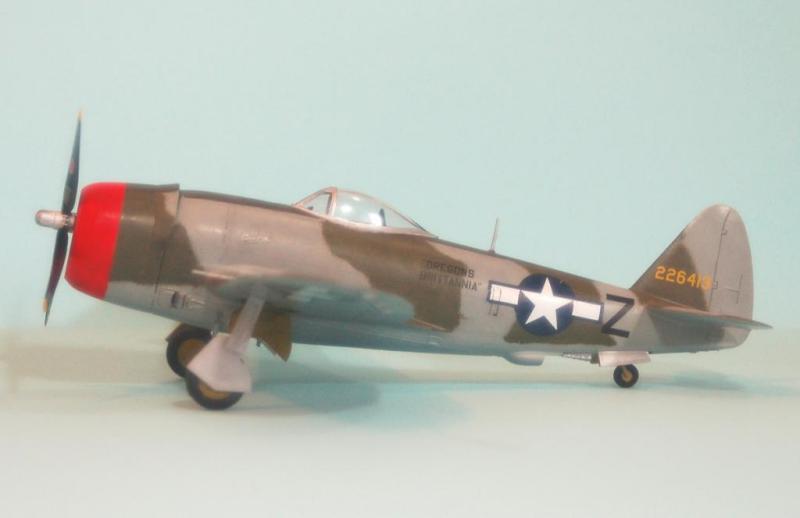
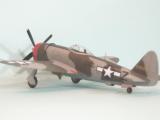
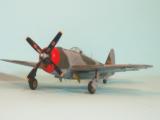
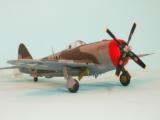
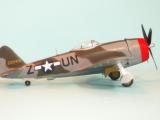
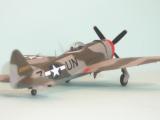
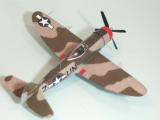
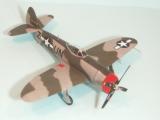
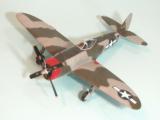
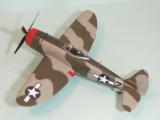
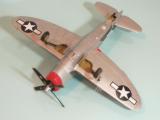
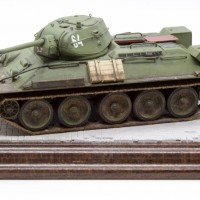
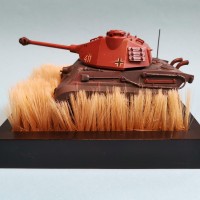
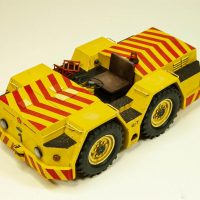
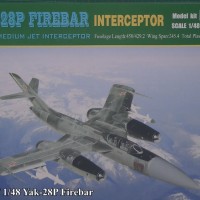
Nice work and a fine story Tom.
Thanks for posting.
Wishing you and your family a very happy New Year.
Great narrative, good looking plane, different paint finish.
Nice one Tom, and it confirms my high opinion of that kit - I have been coaxing my son through building it (he's 9) - in fact a build of Gabby's P-47 I posted here much earlier was to encourage him to build his Hobby Boss kit - he wanted us to build them in the same markings (although I built the Tamiya). I was very impressed with the HB kit in the box, and totally agree it makes a good 'early stages' kit for a builder just coming up the curve.